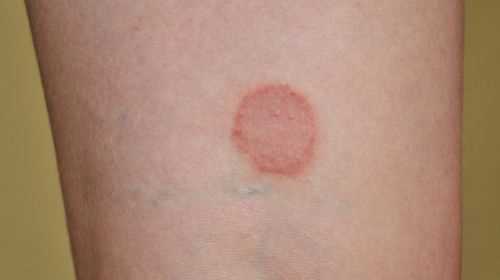A boil occurs when bacteria penetrate deep into a hair follicle and cause inflammation. In the area of the infected hair follicle, a small, painful nodule develops, which quickly enlarges and fills with pus.
A boil is a purulent and painful inflammation of the hair follicle that extends deep into the skin tissue, also known as a hair follicle. The hair follicle is a tubular invagination of the skin that surrounds the hair follicle. A boil can form when bacteria – especially staphylococci – get from the surface of the skin into a hair follicle. Boils usually develop in the genital area, on the buttocks, on the vagina or on the face.
Article content at a glance:
Symptoms of the boil
A boil always develops from a superficial inflammation of the hair follicle (folliculitis). The first symptom of a boil is therefore a small, red-fringed, white-yellowish filled pustule, in the center of which a hair can often be seen. Initially, the inflammation is limited to a single hair follicle. However, the infection quickly spreads to the surrounding tissue, often also to neighboring hair follicles. Inside the boil, skin tissue dies (necrosis) and pus accumulates due to the persistent inflammation. As a result, the boil grows rapidly in a short time and can reach a size of about two centimeters.
If several boils develop side by side, they can fuse together to form a large-area carbuncle. Carbuncles occur mostly in the neck and are very painful. The general symptoms of the disease are often more pronounced in a carbuncle, and some people suffer from severe exhaustion, fever and chills.
Pus formation creates pressure
Due to the formation of pus, the boil is under pressure, the skin above the boil is tense and a plug of pus or a yellowish-brown crust made up of dead tissue and pus can often be seen.
Sometimes a boil has mild general symptoms, such as a high temperature. If the spreading bacteria penetrate the lymph vessels of the skin, they can become inflamed (lymphangitis) and the lymph nodes around the boil swell painfully (lymphadenitis). If the pathogen gets into the bloodstream, blood poisoning (sepsis) occurs with a high fever and drowsiness.
Staphylococcus aureus most common cause of boils
The most important cause of the development of a boil is the bacterium Staphylococcus aureus. In many people, the pathogen colonizes the mucous membranes of the nose and throat. Boils are therefore often caused by self-infection: the pathogen gets from the mucous membranes of the nasopharynx to the surface of the skin through a smear infection and can penetrate the hair follicles there. In addition, with direct physical contact, the pathogen can also be transmitted from person to person or through infected objects. The pathogen normally colonizes the mucous membranes of the nose and throat, but can get onto the skin via a smear infection and cause inflammation of the hair follicles in the genital area, buttocks or face.
Illnesses, medication and a lack of hygiene favor boils
Although bacteria are the actual cause of boils, there are also various other factors that favor the painful inflammation of the hair follicle:
Eye diagnosis is usually sufficient
In the case of a boil, the doctor makes the diagnosis based on the typical appearance. In addition to looking at the inflamed skin, no special examinations are usually necessary. If you feel sick and have very pronounced symptoms, your body temperature is also measured as part of the boil diagnosis and, if necessary, a blood test is carried out to rule out blood poisoning.
Smear and blood test for recurring boils
Some people suffer from boils over and over again, and often multiple boils occur at the same time. Experts then speak of a furunculosis. Furunculosis is often caused by a physical illness, such as untreated diabetes mellitus or an immune deficiency.
If furunculosis is present, the diagnosis also requires a smear. A laboratory examination of the pus can clearly identify the pathogen and treat those affected with a suitable antibiotic. A blood test is also advisable if the boils recur, as a physical illness can be responsible for the recurring infections.
Boils usually do not need treatment
Often times, a boil does not require special treatment. Many boils break open on their own after a few days, the pus empties and the wound can then heal. However, the affected part of the body should be kept still as much as possible and spared for a few days. In the case of boils on the face, it is also advisable to avoid solid foods and to eat liquid or very soft foods that do not have to be chewed for a few days.
Ointments and poultices promote the healing process
To aid the healing process, it can be helpful to disinfect the inflamed skin or to apply an antibiotic ointment. So-called “pull ointments” or warm, moist compresses can accelerate the maturation of the boil so that it breaks up more quickly and can then heal. If the boil is very painful, the doctor’s office can open it with a tiny prick with a scalpel.
If the bacteria have penetrated the lymphatic or blood vessels, however, the boil therapy always requires the use of antibiotics. Local treatment with an antibiotic ointment is not sufficient in this case. Treatment with antibiotics is also useful for facial boils due to the risk of complications.
Never express boils yourself
Regardless of where the boil is, sufferers should never try to open or express the boil on their own. For most boils, the process is straightforward. The pain a boil causes can be very uncomfortable. As soon as the boil opens and deflates after a few days, the symptoms subside and the wound heals, so there is no need for further treatment. Since it is a deep skin infection, it usually leaves a small scar.
What complications can cause boils
Sometimes boils or carbuncles cause more serious complications, for example when the bacteria enter the lymphatic vessels or blood vessels. There is a painful inflammation of the lymph vessels and lymph nodes or blood poisoning with a high fever and drowsiness. Boils on the face can also cause cerebral vein thrombosis, i.e. a blood clot in the brain, or meningitis if the pathogens get into the bloodstream.
Prevention through hygiene
A boil can partly be prevented by simple hygiene measures. The main cause of boils, the pathogen Staphylococcus aureus, is widespread. In up to 70 percent of people, it temporarily or even permanently colonizes the mucous membranes of the nose and throat. From here it can get to the surface of the skin relatively easily – and from there it can also spread to other people. Also about Infected objects can be transmitted.
Good personal hygiene is therefore helpful to prevent boils. This includes not only good hand hygiene and washing yourself regularly, but also changing towels, bed linen and clothes regularly. Anyone who already suffers from a boil can also reduce the risk of passing the pathogen on to other people in this way.
.


